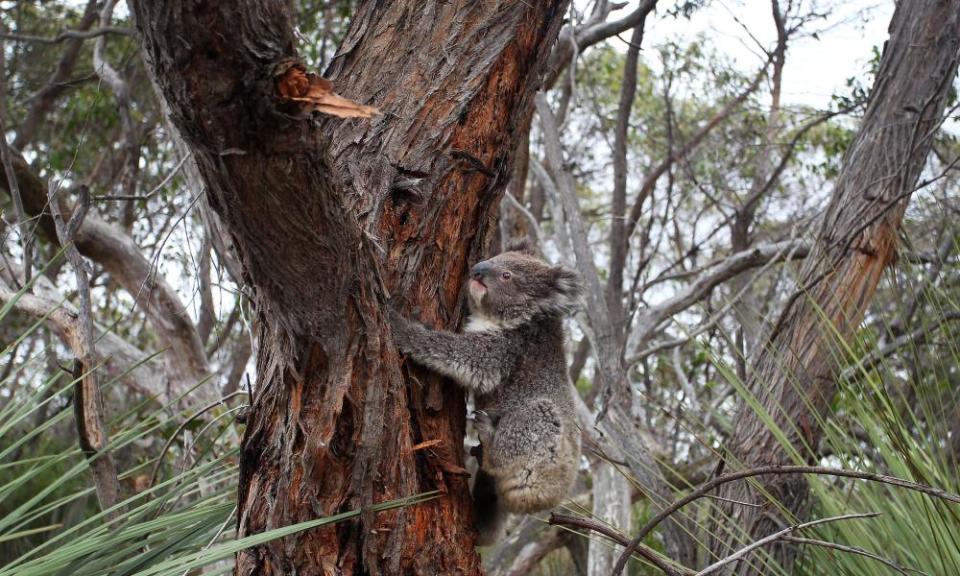Bush and koalas found to be threatened by 'gratuitous' NSW land-clearing plan

Tens of thousands of hectares of bush could be at risk under a New South Wales government proposal to allow rural landholders to clear up to 25 metres of land from their property’s fence line, analysis by WWF-Australia shows.
The NSW government announced this month it planned to amend its Rural Fires Act to allow clearing without an approval on rural property boundaries to reduce bushfire risk.
The proposal, which was not one of the 76 recommendations from the NSW bushfire inquiry, prompted alarm it could lead to broad-scale clearing of endangered forest and habitat and was called “anti-science” by the independent MLC Justin Field.
WWF-Australia used spatial data to examine how much forest could be exposed under the proposed changes in four local government areas: Clarence Valley, Port Stephens, Shoalhaven and Wollondilly.
Related: Koalas still under threat in NSW despite Berejiklian's ultimatum to Nationals
It found if all rural property holders cleared to the maximum extent, 44,293ha of forest could be at risk in those four council areas, 32,609ha of that in Clarence Valley. The analysis found 12,000ha of at-risk forest in those regions was high quality koala habitat unless the state government imposed conditions to protect it.
Martin Taylor, a conservation scientist at WWF-Australia, said there would be landholders who would not clear their land if the proposal passed the state parliament.
“But this is what is at risk of being cleared if they go ahead and do it,” he said. “It’s gratuitous. You’re fragmenting forests even more than they are already. Particularly for koalas, it makes it harder for them to get around.”
NSW laws already allow property owners to clear trees within 10 metres of a house or other building, and shrubs within 50 metres, to mitigate bushfire risk. The proposed rules would allow an additional 25 metres of clearing at the boundary.
Property owners are also permitted to clear distances of 15 metres in coastal NSW, 30 metres in central NSW and 40 metres in western NSW to construct or maintain rural infrastructure, such as a fence.
The greatest impact of the proposed changes is expected to be in coastal zones that have been most exposed to bushfires.
Field expressed concern the government still had not presented any advice it had received from the NSW RFS before announcing the proposed amendments earlier this month.
He said the emergency services minister, David Elliott, “has not been willing to explain” how the proposal would reduce bushfire risk, nor why it had been prioritised over the 76 recommendations from the bushfire inquiry report.
“My concern is it will be developers that use this,” Field said.
“I also worry that it sends the message that this is a constructive way to manage bushfire risk. It sets us up for failure.”
The government is likely to introduce the legislation to parliament in November. It has said it would develop a code to take account of endangered species and habitat but it is unclear what this would entail and whether it would be introduced at the same time.
Elliott did not respond to questions from Guardian Australia.
Field said the government needed to ensure protections were in place for riparian zones, such as creek lines, critically endangered habitats, and threatened species, including the koala. He feared the laws could end up being used for purposes unrelated to bushfire risk.
“I’m particularly concerned by coastal rural land that’s held by developers who may have an intention for future rezoning,” he said.
“They would be allowed to clear their boundaries whether or not they had a fence, effectively degrading the environmental values of their land – not for bushfire protection but to assist with future rezoning applications.”
Related: NSW will allow land to be cleared up to 25m from property boundary, citing bushfire concerns
There are also questions about how the proposed changes would interact with existing land-clearing laws that have caused turmoil inside the government in recent months.
The lower house has passed amendments to local land services laws to exempt private rural landholders from having to recognise the expanded definition of koala habitat under the koala state environmental planning policy (Sepp) that nearly split the Coalition.
If the changes pass the upper house, they would grandfather the arrangements under the koala Sepp for the five councils that already have approved koala plans of management.
But the Environmental Defenders Office said if additional councils completed their own plans in future, the changes would allow private landholders to continue to do code-based land-clearing without an approval.
Rachel Walmsley, the EDO’s policy and law reform director, said the deal reached between the Liberal and National parties was “not about clarifying the laws. It’s about weakening.
“It is actually preventing koala habitat from being mapped and applicable.”
NSW has already recorded huge increases in land-clearing rates as a result of changes to native vegetation laws in 2017.

 Yahoo Finance
Yahoo Finance 